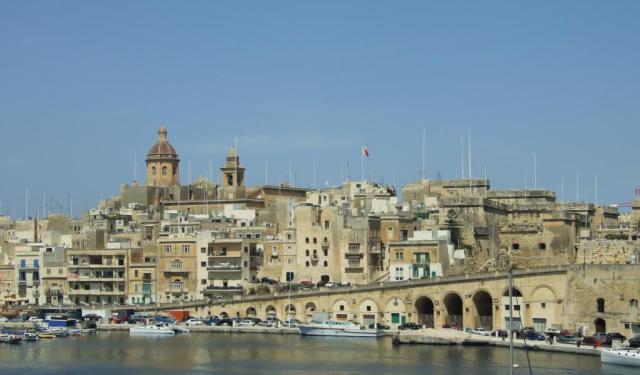
Notre Dame Gate, Birgu
Constructed in 1675 under the auspices of the Order of Saint John, the grand baroque Notre Dame Gate served as the main gate for the Eastern Provinces and is a remarkable testament to the island's architectural heritage. It remains remarkably intact, boasting unique features that set it apart from other structures in Malta. Rising four stories high, it stands as the tallest edifice in the region, offering visitors breathtaking panoramic views of the island from its rooftop.
The gate complex is comprised of four large bomb-proof casemates, each stacked atop the other and flanking the roadway. These casemates are crowned by a magnificent gatehouse, which originally housed the lifting mechanism for the portcullis gate—an impressive piece of engineering in its time. As one explores this historic building, it becomes evident that it carries the scars of its past. Musket ball indentations are etched into the stone, serving as a poignant reminder of the conflicts and battles that have unfolded here. Additionally, countless graffiti left behind by soldiers from the Order's navy, as well as the French and British, provide glimpses into the gate's varied and colorful history.
Over the years, Notre Dame Gate's purpose evolved. In 1870, the construction of the nearby Cottonera Military Hospital led to the gate assuming a new role as an adjunct to the medical establishment. During the Great War, following the Gallipoli campaign's tragic events in 1915, Malta became a critical hub for treating wounded troops. Notre Dame Gate played a part in this effort, accommodating some of the injured soldiers during their treatment and convalescence.
The gate complex is comprised of four large bomb-proof casemates, each stacked atop the other and flanking the roadway. These casemates are crowned by a magnificent gatehouse, which originally housed the lifting mechanism for the portcullis gate—an impressive piece of engineering in its time. As one explores this historic building, it becomes evident that it carries the scars of its past. Musket ball indentations are etched into the stone, serving as a poignant reminder of the conflicts and battles that have unfolded here. Additionally, countless graffiti left behind by soldiers from the Order's navy, as well as the French and British, provide glimpses into the gate's varied and colorful history.
Over the years, Notre Dame Gate's purpose evolved. In 1870, the construction of the nearby Cottonera Military Hospital led to the gate assuming a new role as an adjunct to the medical establishment. During the Great War, following the Gallipoli campaign's tragic events in 1915, Malta became a critical hub for treating wounded troops. Notre Dame Gate played a part in this effort, accommodating some of the injured soldiers during their treatment and convalescence.
Want to visit this sight? Check out these Self-Guided Walking Tours in Birgu. Alternatively, you can download the mobile app "GPSmyCity: Walks in 1K+ Cities" from Apple App Store or Google Play Store. The app turns your mobile device to a personal tour guide and it works offline, so no data plan is needed when traveling abroad.
Notre Dame Gate on Map
Sight Name: Notre Dame Gate
Sight Location: Birgu, Malta (See walking tours in Birgu)
Sight Type: Attraction/Landmark
Guide(s) Containing This Sight:
Sight Location: Birgu, Malta (See walking tours in Birgu)
Sight Type: Attraction/Landmark
Guide(s) Containing This Sight:
Walking Tours in Birgu, Malta
Create Your Own Walk in Birgu
Creating your own self-guided walk in Birgu is easy and fun. Choose the city attractions that you want to see and a walk route map will be created just for you. You can even set your hotel as the start point of the walk.
Birgu Fortifications Walking Tour
The defensive complex surrounding Birgu, Malta, began to take shape in the early Middle Ages when Fort Saint Angelo was built circa the mid-1200s. The majority of other fortifications here were erected between the 16th and 18th centuries under the auspices of the Order of Saint John.
Remarkably, a significant portion of Birgu's fortifications remains well-preserved to this day and have... view more
Tour Duration: 1 Hour(s)
Travel Distance: 2.6 Km or 1.6 Miles
Remarkably, a significant portion of Birgu's fortifications remains well-preserved to this day and have... view more
Tour Duration: 1 Hour(s)
Travel Distance: 2.6 Km or 1.6 Miles
Birgu Introduction Walking Tour
Birgu, also known as "Victorious City", is an ancient fortified town on the southern shore of the Grand Harbour in the South Eastern Region of Malta. It occupies a prominent piece of land, with Fort Saint Angelo crowning its apex and the town of Cospicua resting at its base.
The name "Birgu" traces its roots to the Arabic word "Borgo," meaning a small town. Over... view more
Tour Duration: 1 Hour(s)
Travel Distance: 1.4 Km or 0.9 Miles
The name "Birgu" traces its roots to the Arabic word "Borgo," meaning a small town. Over... view more
Tour Duration: 1 Hour(s)
Travel Distance: 1.4 Km or 0.9 Miles


